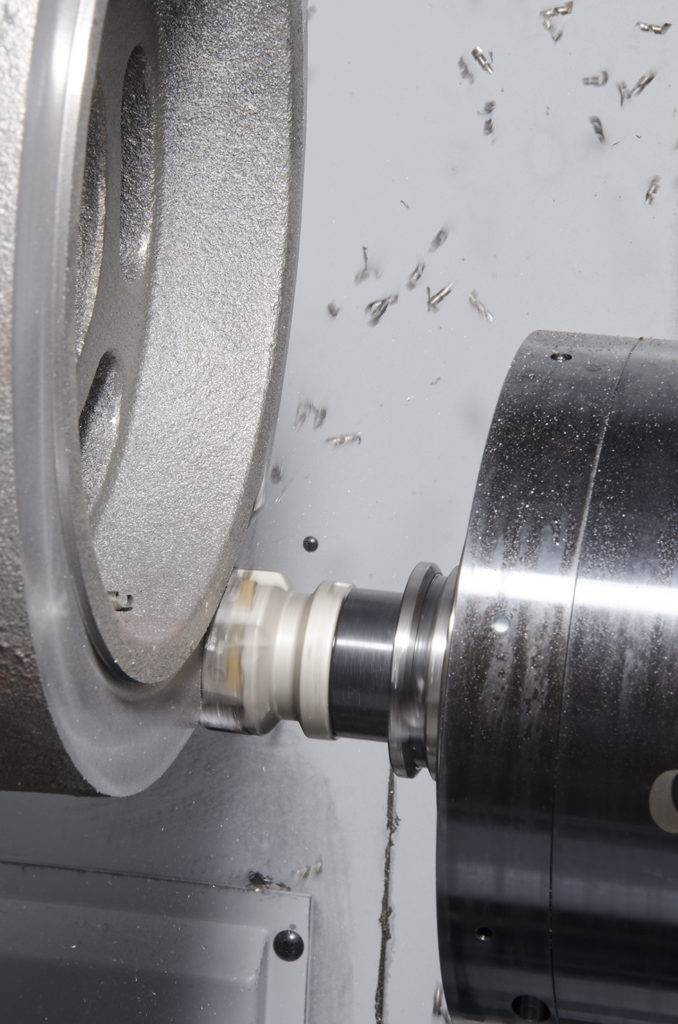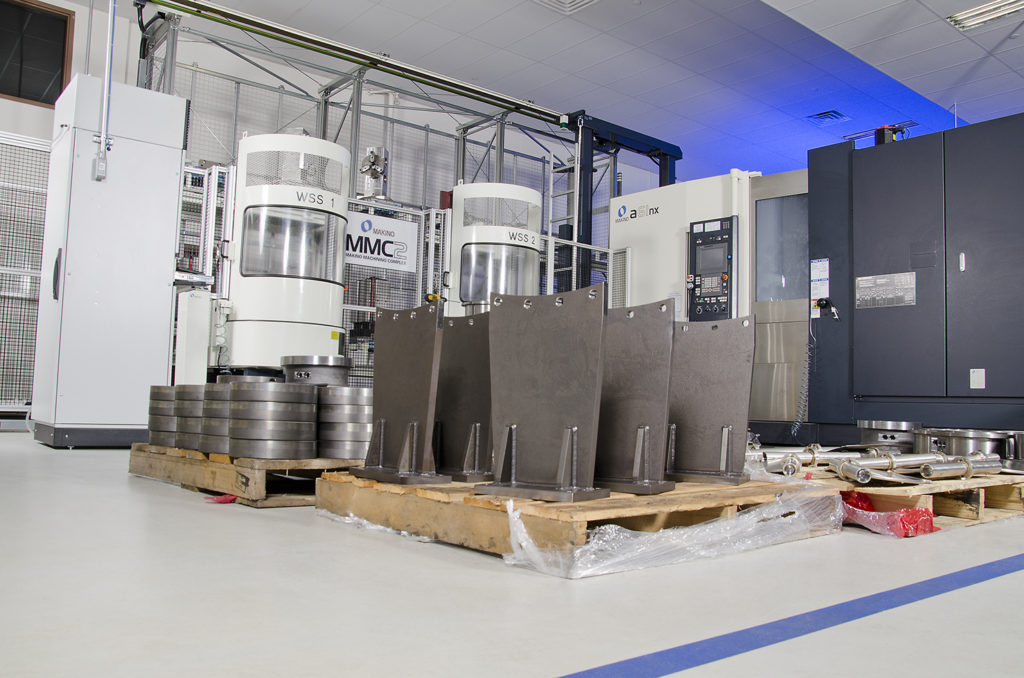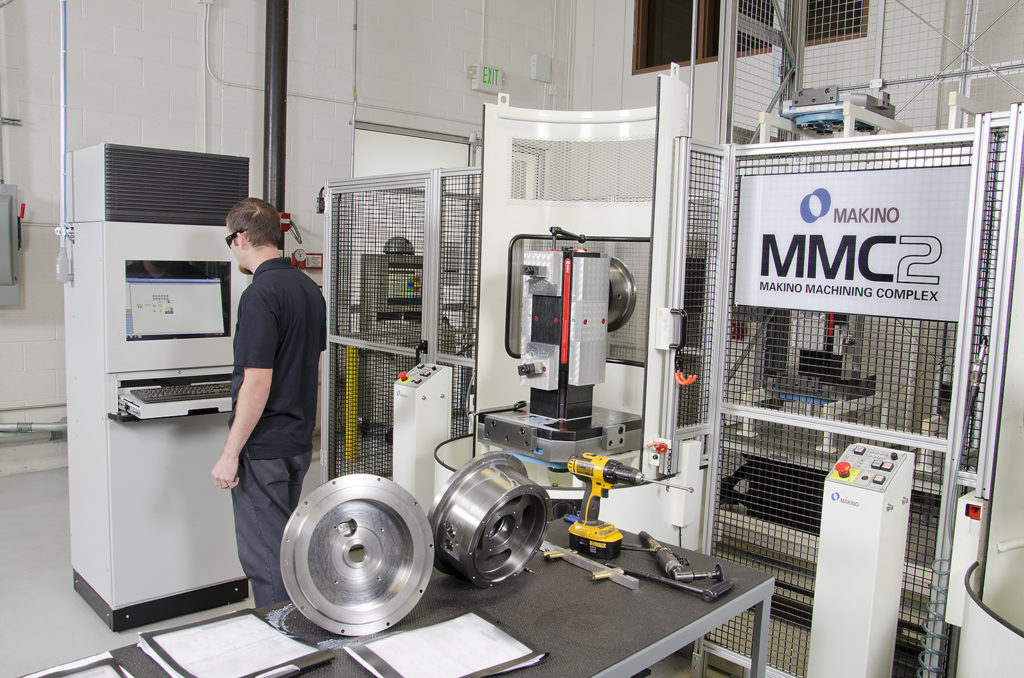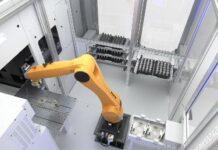Densely populated Southern California is a highly competitive region for small machine shops. When bidding for new work, these businesses know that the competition is likely to be stiff. Always keeping an eye on the bottom line, many shops carefully consider any big equipment investments because they count on every dollar to compete with the guy down the street.
At the same time, a challenge for many shops is being more efficient by reducing part setups in order to achieve faster turnaround and ultimately lower part costs, especially on repeat jobs. Axxis Corporation of Perris, Calif., was no stranger to this situation, but set its sights on improving flexibility and labor efficiencies to drive down part costs for its customers. This goal set Axxis on a journey to identify new solutions that could reduce setup hours, particularly in short cycle time applications. Axxis found it’s answer in 2014 with the purchase of a Makino a61nx horizontal machining center with a 12-pallet MMC2 automated machining cell.
 “The competitiveness of today’s market requires a steadfast determination to constant improvement,” said Brandy Tidball, CEO of Axxis. “Our investment in the a61nx flexible manufacturing system has proven to our customers that Axxis Corporation is never satisfied with the status quo. We now have the flexibility to offer smaller economic order quantities at a lower cost, while achieving four times the production speed and three times the tool life of previous processing methods. It’s this level of performance that enables us to provide outstanding quality and service to current customers, while taking on a more cost-competitive positioning in winning additional work.”
“The competitiveness of today’s market requires a steadfast determination to constant improvement,” said Brandy Tidball, CEO of Axxis. “Our investment in the a61nx flexible manufacturing system has proven to our customers that Axxis Corporation is never satisfied with the status quo. We now have the flexibility to offer smaller economic order quantities at a lower cost, while achieving four times the production speed and three times the tool life of previous processing methods. It’s this level of performance that enables us to provide outstanding quality and service to current customers, while taking on a more cost-competitive positioning in winning additional work.”
A New Way of Operating
Axxis Corporation was established in 2007, after Brandy Tidball acquired an existing job shop that produced parts for the automotive aftermarket and energy, aerospace and medical-device markets. Tidball and his leadership team observed several opportunities for improvement within the shop that could drive down customer prices. After reorganizing thecompany and pursuing new business opportunities, Axxis Corporation knew it was time to focus on investing in new equipment in order to lower costs and improve service.
“We thought that obtaining new high-performance equipment could improve efficiencies,” said David Butler, operations manager at Axxis.
Axxis saw the opportunity to improve flexibility and grow the business by more efficiently managing a wide variety of part quantities and materials, including aluminum, stainless steel, carbon steel, plastics, high-temperature alloys and magnesium.
Axxis personnel initially looked for a high-performance, stand-alone horizontal machine with an envelope that would fit the company’s current parts. The goal was to consolidate operations, increase utilization rates and boost reliability. Axxis personnel were thorough in their research, talking to several distributors about HMC technologies and visiting many online forums to see which companies were being discussed. One of those distributors was Single Source Technologies (SST), a national distributor of machine tools, related consumables, tooling and EDM supplies.
“We showed everyone our components and products, and all agreed that the horizontal machine was the best approach for our parts,” said Butler. “But we were also looking for a vendor that could offer us great support. Our SST salesman, Wes Colony, immediately responded to our RFQ [request for quote] and was quick to respond in great detail.”
Colony introduced Axxis to another company using the same equipment. This customer had a horizontal machining center with an MMC2 automated pallet-handling system. While familiar with these flexible systems, the staff at Axxis had never seen one at work.
 “We had not initially considered such an automated system, but when we talked to this user, they raved about how it had completely eliminated repeat setups,” said David McClure, production lead at Axxis. “Hearing this made us wonder what improvements and innovations our experienced staff could accomplish with this level of technology. We knew we had lots of parts with long setup times and short cycle times that would be ideal for this type of operation. That’s when we decided that it was the right time to look beyond a stand-alone horizontal machine.”
“We had not initially considered such an automated system, but when we talked to this user, they raved about how it had completely eliminated repeat setups,” said David McClure, production lead at Axxis. “Hearing this made us wonder what improvements and innovations our experienced staff could accomplish with this level of technology. We knew we had lots of parts with long setup times and short cycle times that would be ideal for this type of operation. That’s when we decided that it was the right time to look beyond a stand-alone horizontal machine.”
Axxis began exploring the potential of an automated horizontal machining cell with pallet system.
“The efficiencies it could provide were really key,” said Butler. “We realized it could not only help us reduce setups but also combine operations, track tooling and improve scheduling. To actually see and touch it and have someone demonstrate how it works was compelling. When we left that shop, we knew it was time to make the move to automation to improve flexibility for improved delivery and more cost-effective production of smaller part quantities.”
The company’s next objective was identifying the best supplier to help Axxis meet its goals. SST brought in specialists from Makino’s facility in Mason, Ohio, along with representatives from other vendors who would be supplying equipment. Together, they helped to answer the company’s questions and to discuss its needs.
“SST made sure every question we had was answered, and not everyone did that,” said Butler. “They didn’t just say, ‘It will work’—they showed us how. They proved it. They rationalized how this equipment was not only affordable, but would support us in our mission to drive down costs for our customer. They also brought in representatives for tooling, probing and other kinds of equipment to answer questions and validate the capabilities of the equipment.
“We realized that the cell controller would require some adjustment and training to use effectively right out of the box. While many other companies were fine taking four, five or even six months to become accustomed to their new equipment, we wanted our customers to see immediate improvements with a smooth transition. When it came down to it, we wanted the provider that could help us get up and running immediately after installation. SST was, hands down, the supplier we felt most confident with.”
Efficiently Up and Running
Axxis purchased a Makino a61nx with 12-pallet MMC2 system in 2014. Prior to the cell’s installation, Axxis personnel attended training at Makino’s facility in Mason to learn how to optimize the cell’s machine and controls.
“We thought we would be in a class with other companies, but were pleasantly surprised to learn that the training was tailored to our needs. We worked on a system that was identical to the one we had purchased, and Makino customized the software and taught us about the specific features we should be using. It made us feel completely comfortable with the cell’s MAS-A5 control system to use it on our own,” said Butler.
During installation, SST was the single point of contact on all equipment, and Colony also coordinated ordering and setting all of the tombstones and vises.
“The process was very streamlined,” said Butler. “We picked a configuration and they made it work. We had lots of people coming in and out, and SST took the brunt of the scheduling—communicating between all parties. There was great communication between those handling tasks such as the machine setup, tooling and probing. The project was achieved exactly how they [SST] explained it.
 “The crew that installed the system was very thorough. I mentioned that we might add another machine in the future, and when they were leveling the floors, they were forward-thinking enough to level additional flooring for that future machine. It was all very thoughtful and precise.”
“The crew that installed the system was very thorough. I mentioned that we might add another machine in the future, and when they were leveling the floors, they were forward-thinking enough to level additional flooring for that future machine. It was all very thoughtful and precise.”
Once everything was installed, Axxis began running parts without delay. And already, after just a couple of months of using the system, Axxis is loading its catalog of parts into the system and seeing positive results. The MMC2 has given the company the additional throughput it needed, along with workflow optimization.
“With the cell, we are able to push things harder,” said McClure. “We have seen a 50 percent reduction in cycle times, thanks to the improved speeds, feedrates and reduction in operations. On one of our engine-mount parts, we went from 25 minutes to 13 minutes, or two-and-a-half parts per hour to four parts per hour. This is a commentary on the speed of the machine, and is definitely over and above what I would have achieved in a commodity horizontal machine.”
A significant portion of this timesaving is because the machining processes are no longer coupled to setup operations, so the spindle has virtually no downtime.
“The control system allows us to store programs and fixture data for repeat orders, eliminating requirements for extended setup times,” said McClure. “With the increased spindle utilization, we achieve more parts and make our customers happy. Altogether, we are getting four times the overall productivity and four times the ROI compared to our previous equipment.
“Another reason that we are experiencing far less downtime is simply because we don’t have to manually change out tools. Additionally, the machine’s rigidity gives us tighter tolerances and better tool life. In fact, we’ve seen up to three times the tool life compared to our prior technologies, further reducing cost per part.”
Holding those tighter tolerances means accuracy has been improved. For example, one part used to require several mill operations and lathe operations. Now all operations are done on one machine in a single setup, reducing variation and holding necessary tolerances. In addition, parts can be checked and deburred while the machine is running.
“As far as accuracy, we have a part where we need to hold tolerances of plus or minus 0.0005 inch. Our previous machines required four endmills per job to hold this tolerance. But we just completed the entire job with only one endmill on the a61nx due to the machine’s rigidity and through-spindle coolant, which flushes chips out of the part. These features allow us to achieve more high-speed cutting paths, really lowering our cost per part for customers,” McClure said.
As it improved accuracy, the company also began to enhance processes with weekly management meetings to discuss its work in process. In addition, Axxis started using the system to collect data in order to improve any bottlenecks and increase throughput.
“We were able to cut our work in process in half. We now have better visibility and flexibility in our production schedules, based on data collected by the MMC2 cell,” said McClure.
The cell has especially been a perfect solution for short-run, high-mix applications.
“The automated cell has certainly helped with our repeat jobs,” said Butler. “We can eliminate setups and provide quicker turnaround and better pricing. And today, if a customer’s job sits for a week while they approve a prototype part, we can run a variety of other orders without concern for when we’ll need to get the order fixture and back into production. We can also easily produce a one-off part if a customer asks for something extra that was not in the original order. This kind of flexibility means that we try to push every job through our cell, because once it’s in there, we can always pull the program and go.”
With this flexibility, Axxis has seen organic growth in its current customer base and has also gained new customers as it looks to expand into the medical market.
“Our shop motto is to look at the big picture so that we can continue to grow, and this equipment fits right in with that,” said Butler.
Taking Customer Service to the Next Level
Having achieved its goals for improving customer part costs and flexible delivery, Axxis is looking forward to eliminating overrun and reducing standing inventory as it continues to establish additional jobs in its cell.
“What matters most to Axxis is providing outstanding customer service,” said Butler. “We want our clients to be satisfied because we have supplied them with a quality part on time and in a cost-effective way. This is our niche.”
To achieve its goals, Axxis plans to further expand its cell with 24 pallets and a second a61nx. It hopes to further improve its process by running parts overnight, doubling the business.
“We want to be the number one machine shop, growing to the point where our name is widely known throughout the market as doing whatever it takes for our customers,” said Butler. “We know that by achieving our goal of making our production even more efficient has given us a newfound flexibility to help our customers achieve their goals.”



















